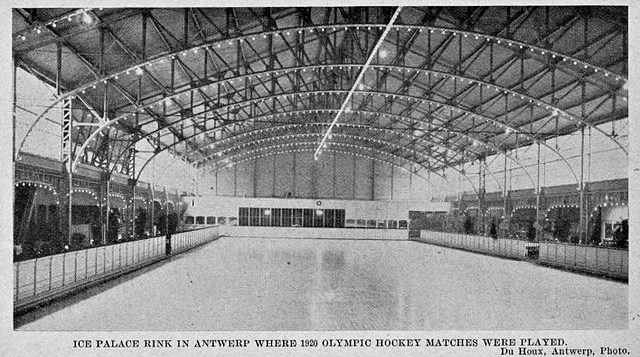This Day in Hockey History – April 26, 1920 – Ice in Summer
The NHL had existed for three seasons when ice hockey truly went international. Ice hockey was first made an Olympic sport just in time for the 1920 Summer Games held at Antwerp, Belgium (since Winter Games did not yet exist). Antwerp’s Le Palais de Glace arena would only allow figure skating events with the inclusion of hockey matches. Although bandy was still more popular in Europe, the Ligue International de Hockey sur Glace (today’s International Ice Hockey Federation (IIHF)) was founded in 1908 and held European championships as early as 1910. For the 1920 Olympics, the IIHF welcomed in Canada and the United States as members.
The two North American teams and five European teams (Sweden, Switzerland, Czechoslovakia, France, and the home team, Belgium) agreed to participate in that first Olympics. As a result of the First World War, Germany and Austria did not attend. The Falcon Hockey Club of Winnipeg, featuring mostly Icelandic Canadiens, represented Canada. Their entire team had enlisted and played hockey for the 223rd Battalion during the war and returned to win the Allan Cup championship. Funny enough, the U.S. team featured four Canadian-born players out of the eleven they brought to the Olympics. Sweden basically outfitted bandy players in soccer uniforms. IIHF President Max Sillig skated with Switzerland as the first acting president to take part in a World Championship. William Hewitt (father of Foster Hewitt, the voice of Canadian hockey for 40 years) officiated and described the Czechs saying, “They run on their skates with clumsy movements and use wrist shots and their play is all individual.” As the Games would show, at the time, the Europeans just could not keep up with the North Americans.
Since all the teams played by different rules, the Olympics went with seven-man hockey (including the rover position already eliminated from North American hockey) with no substitutions allowed (meaning both teams would sit a player if someone was injured). The games were played with two 20-minute sessions broken up by a 10-minute intermission. Immediately after the 1920 Olympics, they switched the rules to six-man hockey and three 20-minute periods.
The tournament system, created by Erik Bergvall (for water polo in the 1912 Olympics), essentially had the teams play for the gold medal, then set up everyone who lost against the winning team to play for the silver, and finally the losers to the bronze team played again for the bronze. The tournament ended up having ten games, and only two were close in score. The quarter-finals, played on April 24, resulted in three shutouts. Canada blanked Czechoslovakia 15-0 while the U.S. crushed Switzerland 29-0 and Sweden beat Belgium 8-0. The next day’s semi-finals produced two shutouts. Sweden defeated France 4-0. In what some consider the best ice hockey Europe had seen until that point, the two North American teams faced off against each other. The Canadians pulled off a 2-0 victory.
On April 26, 1920, the gold medal match was held between the undefeated Canada and Sweden. The Canadians dominated tallying 12 goals. However, it was the sole goal for Sweden that received all the attention. An Associated Press article described the play. “Sweden’s goal was scored in the first half, after ten minutes of play, and came as an utter surprise to the Canadians. The victors had easily scored five goals, when [Einar] Svensson, the Swedish right defence, carried the puck down near to the Canadian goal and drove it into the net, surprising Goalkeeper Byron so much that he fell down.” Not only did that goal prevent a shutout, but it was the only goal scored on Canada during the entire tournament. The Swedes took pride in that accomplishment.
Thanks to the flawed system, the three teams that had lost to Canada had to play for the silver medal. Over the next two days, the U.S. shutout Sweden 7-0 and Czechoslovakia 16-0. With the silver safely in American hands, the other two played each other and Switzerland for bronze. The two games, held April 28 and April 29, also resulted in shutouts. Sweden beat Switzerland 4-0 but ended up missing the podium when the Czechs scored their only goal of the entire tournament. Despite having 31 goals scored on them, their single 1-0 win over Sweden gave Czechoslovakia the bronze. Sweden had won three games, as had Canada and the U.S. The Winnipeg Falcons returned to Canada to celebrate with a parade, banquets, and gold pocket watches. In 2006, the team was inducted into the Canadian Olympic Hall of Fame. They were the first ever ice hockey team to win gold at the Olympics.
Additional Sources:
- Andrew Podnieks, Where Countries Come to Play (Toronto: McClelland & Stewart, 2013), kindle version.
- http://www.usahockeymagazine.com/article/when-ice-hockey-was-summer-sport
- https://www.hhof.com/htmlTimeCapsule/oly1920.shtml
- https://theihlc.com/1920/04/26/ihlc-classics-canada-12-1-sweden-apr-26-1920/
- http://www.winnipegfalcons.com/














